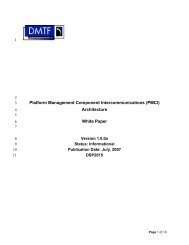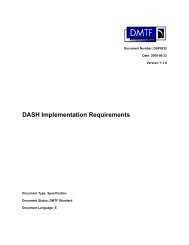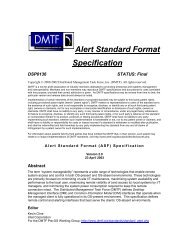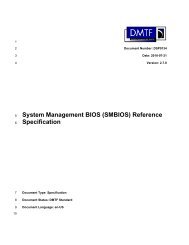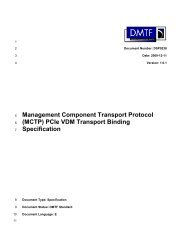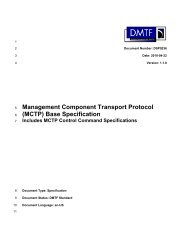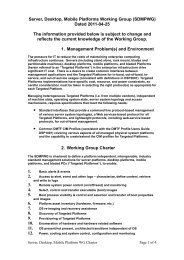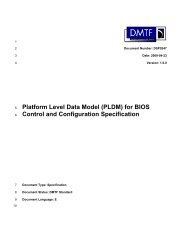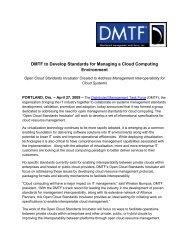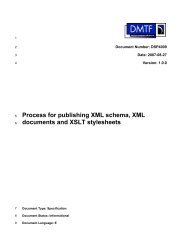Server Management Command Line Protocol Specification - DMTF
Server Management Command Line Protocol Specification - DMTF
Server Management Command Line Protocol Specification - DMTF
You also want an ePaper? Increase the reach of your titles
YUMPU automatically turns print PDFs into web optimized ePapers that Google loves.
<strong>Server</strong> <strong>Management</strong> <strong>Command</strong> <strong>Line</strong> <strong>Protocol</strong> (SM CLP) <strong>Specification</strong><br />
119<br />
Introduction<br />
120<br />
121<br />
122<br />
123<br />
124<br />
125<br />
126<br />
127<br />
128<br />
129<br />
130<br />
131<br />
132<br />
133<br />
134<br />
135<br />
136<br />
137<br />
138<br />
139<br />
140<br />
141<br />
142<br />
143<br />
144<br />
145<br />
146<br />
147<br />
148<br />
149<br />
150<br />
151<br />
152<br />
153<br />
154<br />
155<br />
156<br />
157<br />
This section contains an overview of the <strong>Command</strong> <strong>Line</strong> <strong>Protocol</strong> (CLP). This includes the goals behind<br />
creating the CLP and the specific problems that it attempts to resolve. In addition, this section lays the<br />
groundwork for the sections that follow by detailing the background and assumptions of the CLP. This<br />
includes the architecture assumed in the design of the CLP and the components within that architecture.<br />
Problem Statement<br />
The fundamental problem that is the impetus behind this specification is the growing need to rely on multivendor,<br />
out-of-band hardware and software management solutions as core components of an<br />
interoperable, heterogeneous, enterprise-wide management solution. By extending the <strong>DMTF</strong><br />
specifications to include a CIM-based command line protocol for managing systems and devices, the<br />
<strong>DMTF</strong> comes closer to realizing its vision of enabling end-to-end, multi-vendor interoperability in<br />
management systems.<br />
Principal Goals<br />
The principal goal of this specification is to define a light-weight, human-oriented command line protocol<br />
that is also suitable for scripting environments. This includes a direct mapping to a subset of the CIM<br />
Schema. The command line protocol specifies the syntax and semantics used to allow the manipulation<br />
of the Managed Elements and Associations within servers, as collections or individually.<br />
Solution<br />
The solution proposed in this document is a command line protocol (CLP), which is transmitted and<br />
received over a text message-based transport protocol. The CLP is defined as a character-based<br />
message protocol and not as an interface, in a fashion similar to Simple Mail Transfer <strong>Protocol</strong><br />
(3RFC2821).<br />
The CLP is a command/response protocol, which means that a text command message is transmitted<br />
from the Client over the transport protocol to the Manageability Access Point (MAP). The MAP receives<br />
the command and processes it. A text response message is then transmitted from the MAP back to the<br />
Client.<br />
The CLP is designed to work over existing character-oriented transports. The specification contains<br />
mappings to Telnet and SSHv2, but any transport capable of carrying command/response message data<br />
of the type specified herein may be suitable for use as a transport.<br />
The CLP enables internationalization by providing a mechanism for the Client to indicate to the MAP the<br />
language desired by the Client. Provided the MAP supports the requested language, output data will be<br />
presented to the user with the appropriate translations. This version of the CLP does not support specific<br />
internationalization of user account names and passwords because they can be in any specific language.<br />
In addition, the CLP input (commands and syntax) is not translated because CLP syntax is itself its own<br />
language.<br />
The CLP allows for extensibility through four different mechanisms: verbs, options and option argument<br />
terms, command target terms, and target property terms. The conventions contained herein allow for<br />
implementers to extend the interface in a non-conflicting mechanism that allows for differentiation and<br />
experimentation without encroaching on the standard CLP syntax and semantics.<br />
6 Version 1.0.2



